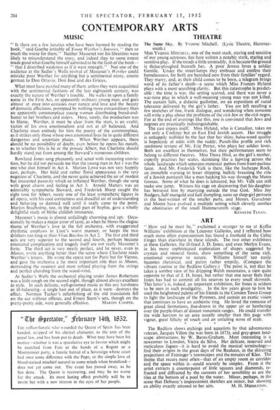ART
" How sad he must be," exclaimed a stranger to me at Kyffin Williams' exhibition at the Leicester Galleries, and I reflected how much more often expressionism has found a foothold in the Celtic fringes than elsewhere in these islands. The two other exhibitors at these Galleries, the ill-fated J. D. Innes, and even Merlyn Evans, in his more sophisticated exploration of shapes suggested -by crystals and mineral forms, show something of the same rich, emotional response to nature. Williams himself too easily becomes rhetorical, and paints rather emptily. (Compare the vibrant routine at the Redfern Gallery.) The point is, not that he takes a sombre view of his dripping Welsh mountains, a view quite opposite to that of J. D. Innes, but rather that one never feels that Innes has had to commit all his reserves to every small skirmish. -This latter's is, indeed, an important exhibition, for Innes is seldom to be seen in such prodigality. In the few years given to him he used the heightened palette of his friends in the Camden Town Group to light the landscape of the Pyrenees, and sustain an exotic vision that continues to have an authentic ring. He loved the romance of great cloud formations, fine-drawn in the upper air or lumbering over the purple-blues of distant mountain ranges. He could transfer the wide horizon to an area usually smaller than this page with vigour, great felicity of touch and an unfailing sense of scale.
The Redfern shows etchings and aquatints by that adventurous veteran, Jacques Villon (he was born in 1873), and grey-green land- scape abstractions by W. Barns-Graham. Most interesting is a newcomer to London, Vieira da Silva. Her delicate, reserved and meticulous fugues—it is hard to avoid the musical terminology— find their origins in the great days of the Bauhaus, in the shivering projections of Feininger's townscapes and the mosaics of Klee. The theme that recurs most often—that of an empty room or corridor and the space within it—could scarcely be simpler. From it the artist extracts a counterpoint of little squares and diamonds, re- fracted and diffracted by the currents of her sensibility as are the tiles at the bottom of a pool by the water. Minor, perhaps, in the sense that Debussy's impressionist sketches are minor, but showing
an ability exactly attuned to her aim. M. H. MIDDLETON.


























 Previous page
Previous page